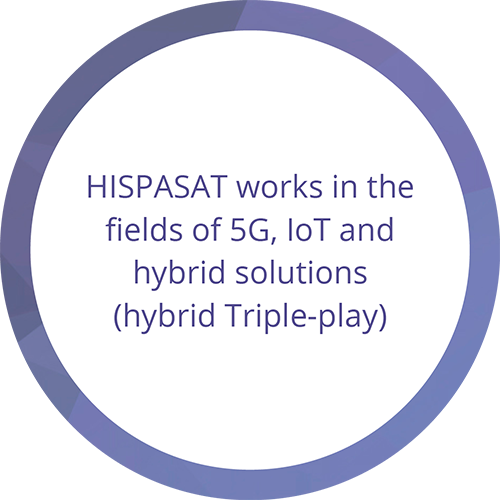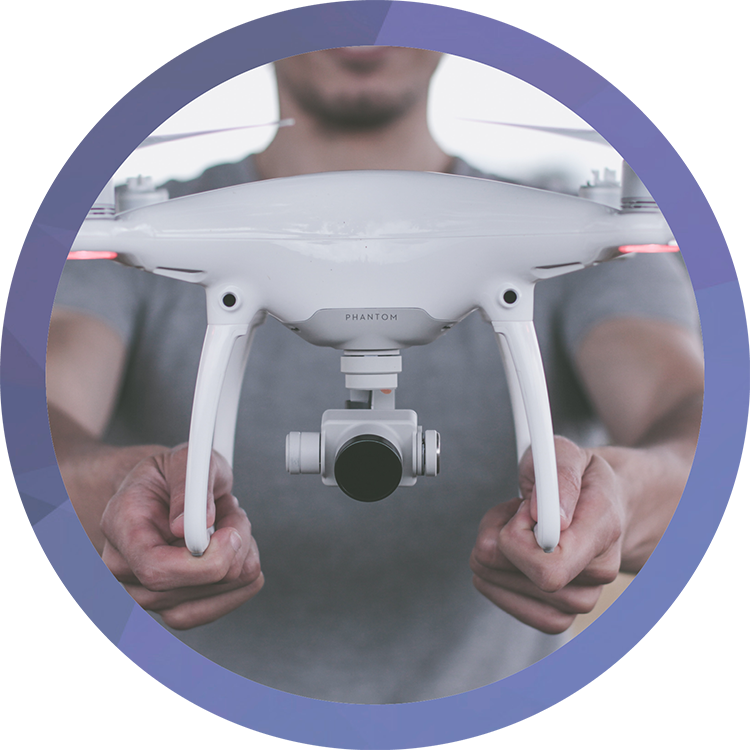HISPASAT understands innovation as a continuous and key process for company business continuity in the future. Internally, innovation is approached from a transversal perspective, in which the professional teams from different company areas take part in multi-disciplinary teams on a project-by-project basis, thus putting their satellite know-how, telecommunications networks and applications at the service of new projects.
Externally, HISPASAT collaborates closely with the main satellite and sector equipment manufacturers, telecommunications operators and benchmark investigation centres.
INNOVATION IN SERVICES AND BUSINESS MODELS
Projects aimed at innovations in services and applications provided via satellite. Projects related to the video, mobility or telecommunications markets fit within this context.
INNOVATION IN TECHNOLOGY AND INFRASTRUCTURE
Projects related to the space and ground infrastructure that HISPASAT uses to provide its connectivity services. Here we find projects that innovate in GEO satellites and new kinds of satellites or High Altitude Pseudo Satellites (HAPs), or innovation in aerial technology.
PROJECTS
VIDEO SOLUTIONS
HISPASAT´s development of high definition UHDTV (4K) technology is ongoing. Thanks to their high capacity, ease of deployment and extensive coverage, the satellites are key for broadcasting high added value contents through HDTV, as they will be through UHDTV. HISPASAT has a specific 4K channel in Europe and North America, using their Hispasat 30W-5 and Amazonas 3 satellites, respectively.
Furthermore, the company has continued to promote the SAT> IP system by offering HISPASAT’s main video customers a technological and service demonstrator that helps operators to understand the technology and the benefits it offers them
MOBILITY
Incorporating connectivity improvements to RENFE’s high speed AVE train fleet has been ongoing for HISPASAT. At present the company provides these trains with a service in collaboration with Telefónica.
In the context of satellite transport connectivity for cars, HISPASAT participated in the Sat2Car project along with PSA Peugeot Citroën, EGATEL, ALTIA and QUOBIS, carrying out laboratory tests and final tests for the Sat2Ca project in order to demonstrate the viability of connectivity in a mobile vehicle from different places and operating conditions.
HISPASAT is driving initiatives aimed at innovating on the ground, as is the case with the development of flat self-orienting aerials that make it easier to deploy satellite solutions. With this objective in mind, HISPASAT is working with the main industrial players in this technology, and in 2018 various studies and demonstrations with Phasor and Kymeta technologies were carried out in the professional vehicle sector.
It is also worth highlighting research tasks around the viability of MiMo solutions for the land sector in mobility applications. Working together with the Centre Tecnològic Telecomunicacions Catalunya (CTTC), the Multiantsat project was carried out. Its aim is to analyse the viability of using this kind of technology, as well as to quantify the advantages of using MiMo techniques with GEO satellites. The study is complete and the second phase of laboratory and field tests is due to be carried out during 2019.
HISPASAT has continued to be strongly committed to the development of satellite connectivity solutions for transport, particularly land and maritime.
NEW APPLICATIONS
As far as 5G activities are concerned, HISPASAT continues to take part in the European Commission project NRG-5, within the H2020 framework, the main objective of which is to improve efficiency in energy management using the characteristics of the 5G environment.
In the IoT context, HISPASAT made an agreement with the manufacturer hiSky to offer accessible voice and data services together with the low capacity IoT service using a small flat antenna based on phased array technology. In 2018, concept tests and validation of the applications to be used with the manufacturer in the personal mobility field were carried out, establishing a link with the satellite and a low-cost and lightweight terminal for making voice calls. Tests were also performed on hiSky terminals on low speed networks. The ultimate goal is to offer these services in remote places and for the mobility market, such as on boats, in connected cars and trains, using this small portable antenna.
Meanwhile, the company worked with a key manufacturer to develop a hybrid data and video solution, using the Ka and Ku bands simultaneously. Satisfactory tests were carried out and the company has a new hybrid Triple play product. This makes it possible to receive TV services via Ku band and to transmit and receive data services via Ka HTS from the same orbit position.
CONNECTING THOSE WITH NO CONNECTION
In order to provide connectivity to areas that ground infrastructure does not reach, HISPASAT has worked together with Telefónica and the King Juan Carlos University on a project to offer 3G connectivity to a group of settlements along the river Napo in Peru, using satellite backhaul for the Internet connection.
HISPASAT is also working on developing a connectivity solution that combines a satellite transport network and a WiFi access solution, to enable Internet access to be delivered quickly, simply and inexpensively in regions where deploying physical infrastructure is difficult and complicated. Together with local partners, HISPASAT has begun to roll out this solution in Colombia.
HISPASAT contributes to bridging the digital divide: The need for connectivity around the world continues to grow, and rural areas are demanding connectivity services that are similar to those that exist in urban centres.
HIGH ALTITUDE PSEUDO SATELLITES (HAPS)
Since 2017, HISPASAT has been working with the main HAP manufacturers in order to evaluate a potential infrastructure that would complement its satellite network and would allow the company to offer broadband services, low-cost backhaul to cellular radio stations, and even communications direct from smartphones to the 4G network and the 5G network in future.
HISPASAT is evaluating possible uses for HAPs (unmanned vehicles like drones, balloons, etc.) located in the stratosphere that could have missions similar to and even complementary to the GEO and LEO satellites, being able to offer requirements similar to 5G, like high throughput and short delay (1 msec).
HISPASAT is dedicating R+D+I resources to evaluating new infrastructures that in the future will allow the company to increase its connectivity services provision capacity.
Paseo de la Castellana, 39 28046 Madrid Spain
+34 91 710 25 40
© Informe Anual Hispasat 2018
Legal Notice
Cookies





